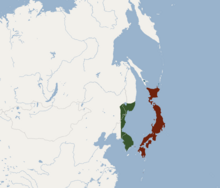Eastern long-fingered bat
Appearance
| Eastern long-fingered bat | |
|---|---|

| |
| Scientific classification | |
| Domain: | Eukaryota |
| Kingdom: | Animalia |
| Phylum: | Chordata |
| Class: | Mammalia |
| Order: | Chiroptera |
| Family: | Vespertilionidae |
| Genus: | Myotis |
| Species: | M. macrodactylus
|
| Binomial name | |
| Myotis macrodactylus (Temminck, 1840)
| |

| |
The eastern long-fingered bat, or big-footed myotis (Myotis macrodactylus) is a species of vesper bat.
Taxonomy
The eastern long-fingered bat was described as a new species in 1840 by Dutch zoologist Coenraad Jacob Temminck. Temminck placed it in the genus Vespertilio, with a scientific name of Vespertilio macrodactylus.[2][3] The holotype had been collected in Japan.[2]
Range and habitat
The eastern long-fingered bat is found in Russian Far East and East Asia, including China, Japan, North Korea, South Korea, and Russia.[1] Within its range, the eastern long-fingered bat is strongly associated with riparian habitat, as it forages for food over rivers.[4]
References
- ^ a b Fukui, D.; Sun, K.; Kruskop, S.V. (2019). "Myotis macrodactylus". IUCN Red List of Threatened Species. 2019: e.T14177A22065868. doi:10.2305/IUCN.UK.2019-3.RLTS.T14177A22065868.en. Retrieved 19 November 2021.
- ^ a b "Myotis macrodactylus". ASM Mammal Diversity Database. American Society of Mammalogists.
- ^ Temminck, C. J. (1840). Monographies de mammalogie, ou Description de quelques genres de mammifères, dont les espèces ont été observées dans les différens musées de l'Europe. Vol. 2. pp. 231–232. Retrieved October 12, 2017.
- ^ Kobayashi, Fumiya; Fukui, Dai; Kojima, Eisuke; Masuda, Ryuichi (2012). "Population Genetic Structure of the Japanese Large-Footed Bat ( Myotis macrodactylus ) Along Three Rivers on Hokkaido Island, Northern Japan". Mammal Study. 37 (3): 227–235. doi:10.3106/041.037.0306. S2CID 27625909.

